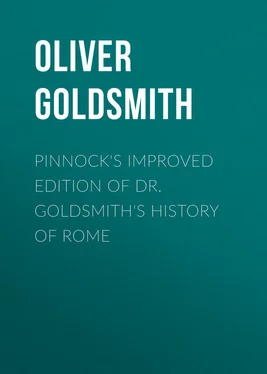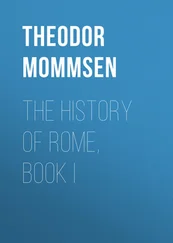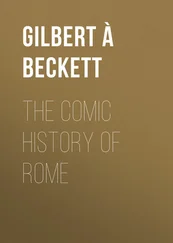Oliver Goldsmith - Pinnock's improved edition of Dr. Goldsmith's History of Rome
Здесь есть возможность читать онлайн «Oliver Goldsmith - Pinnock's improved edition of Dr. Goldsmith's History of Rome» — ознакомительный отрывок электронной книги совершенно бесплатно, а после прочтения отрывка купить полную версию. В некоторых случаях можно слушать аудио, скачать через торрент в формате fb2 и присутствует краткое содержание. Издательство: Иностранный паблик, Жанр: foreign_antique, foreign_prose, на английском языке. Описание произведения, (предисловие) а так же отзывы посетителей доступны на портале библиотеки ЛибКат.
- Название:Pinnock's improved edition of Dr. Goldsmith's History of Rome
- Автор:
- Издательство:Иностранный паблик
- Жанр:
- Год:неизвестен
- ISBN:нет данных
- Рейтинг книги:4 / 5. Голосов: 1
-
Избранное:Добавить в избранное
- Отзывы:
-
Ваша оценка:
- 80
- 1
- 2
- 3
- 4
- 5
Pinnock's improved edition of Dr. Goldsmith's History of Rome: краткое содержание, описание и аннотация
Предлагаем к чтению аннотацию, описание, краткое содержание или предисловие (зависит от того, что написал сам автор книги «Pinnock's improved edition of Dr. Goldsmith's History of Rome»). Если вы не нашли необходимую информацию о книге — напишите в комментариях, мы постараемся отыскать её.
Pinnock's improved edition of Dr. Goldsmith's History of Rome — читать онлайн ознакомительный отрывок
Ниже представлен текст книги, разбитый по страницам. Система сохранения места последней прочитанной страницы, позволяет с удобством читать онлайн бесплатно книгу «Pinnock's improved edition of Dr. Goldsmith's History of Rome», без необходимости каждый раз заново искать на чём Вы остановились. Поставьте закладку, и сможете в любой момент перейти на страницу, на которой закончили чтение.
Интервал:
Закладка:
10. The principal cities in Cisalpine Gaul were Roman colonies with municipal rights; many of them have preserved their names unchanged to the present day. The most remarkable were; north of the Pa'dus, Terge'ste, Trieste ; Aquilei'a; Pata'vium, Padua ; Vincen'tia, Vero'na, all east of the Athe'sis: Mantua; Cremo'na; Brix'ia, Brescia ; Mediola'num, Milan ; Tici'num, Pavia ; and Augusta Turino'rum, Turin ; all west of the Athe'sis. South of the Po we find Raven'na; Bono'nia, Bologna ; Muti'na, Modena ; Par'ma, and Placen'tia. 11. From the time that Rome was burned by the Gauls (B.C. 390), the Romans were harassed by the hostilities of this warlike people; and it was not until after the first Punic war, that any vigorous efforts were made for their subjugation. The Cisalpine Gauls, after a fierce resistance, were overthrown by Marcell'us (B.C. 223) and compelled to submit, and immediately afterwards military colonies were sent out as garrisons to the most favourable situations in their country. The Gauls zealously supported An'nibal when he invaded Italy, and were severely punished when the Romans finally became victorious.
12. North-east of Cisalpine Gaul, at the upper extremity of the Adriatic, lay the territory of the Venetians; they were a rich and unwarlike people, and submitted to the Romans without a struggle, long before northern Italy had been annexed to the dominions of the republic.
13. Central Italy comprises six countries, Etru'ria, La'tium, and Campa'nia on the west; Um'bria, Pice'num, and Sam'nium, on the east.
14. Etru'ria, called also Tus'cia (whence the modern name Tuscany ) and Tyrrhe'nia, was an extensive mountainous district, bounded on the north by the river Mac'ra, and on the south and east by the Tiber. The chain of the Apennines, which intersects middle and Lower Italy, commences in the north of Etru'ria. The chief river is the Ar'nus, Arno . 15. The names Etruscan and Tyrrhenian, indifferently applied to the inhabitants of this country, originally belonged to different tribes, which, before the historic age, coalesced into one people. The Etruscans appear to have been Celts who descended from the Alps; the Tyrrhenians were undoubtedly a part of the Pelas'gi who originally possessed the south-east of Europe. The circumstances of the Pelasgic migration are differently related by the several historians, but the fact is asserted by all. 1 1 See Pinnock's History of Greece, Chap. I.
These Tyrrhenians brought with them the knowledge of letters and the arts, and the united people attained a high degree of power and civilization, long before the name of Rome was known beyond the precincts of Latium. They possessed a strong naval force, which was chiefly employed in piratical expeditions, and they claimed the sovereignty of the western seas. The first sea-fight recorded in history was fought between the fugitive Phocians, 2 2 See Historical Miscellany, Part II. Chap. I.
and the allied fleets of the Tyrrhenians and the Carthaginians (B.C. 539.)
16. To commerce and navigation the Etruscans were indebted for their opulence and consequent magnificence; their destruction was owing to the defects of their political system. There were twelve Tuscan cities united in a federative alliance. Between the Mac'ra and Arnus were, Pi'sæ, Pisa ; Floren'tia, Florence ; and Fæ'sulæ: between the Arnus and the Tiber, Volate'rræ, Volterra ; Volsin'ii, Bolsena ; Clu'sium, Chiusi ; Arre'tium, Arrezzo ; Corto'na; Peru'sia, Perugia , (near which is the Thrasamene lake); Fale'rii, and Ve'ii.
17. Each of these cities was ruled by a chief magistrate called lu'cumo , chosen for life; he possessed regal power, and is frequently called a king by the Roman historians. In enterprises undertaken by the whole body, the supreme command was committed to one of the twelve lucumones , and he received a lictor from each city. But from the time that Roman history begins to assume a regular form, the Tuscan cities stand isolated, uniting only transiently and casually; we do not, however, find any traces of intestine wars between the several states.
18. The Etrurian form of government was aristocratical, and the condition of the people appears to have been miserable in the extreme; they were treated as slaves destitute of political rights, and compelled to labour solely for the benefit of their taskmasters. A revolution at a late period took place at Volsin'ii, and the exclusive privileges of the nobility abolished after a fierce and bloody struggle; it is remarkable that this town, in which the people had obtained their rights, alone made an obstinate resistance to the Romans.
19. The progress of the Tuscans in the fine arts is attested by the monuments that still remain; but of their literature we know nothing; their language is unknown, and their books have perished. In the first ages of the Roman republic, the children of the nobility were sent to Etru'ria for education, especially in divination and the art of soothsaying, in which the Tuscans were supposed to excel. The form of the Roman constitution, the religious ceremonies, and the ensigns of civil government, were borrowed from the Etrurians.
20. La'tium originally extended along the coast from the Tiber to the promontory of Circe'ii; hence that district was called, old La'tium; the part subsequently added, called new La'tium, extended from Circeii to the Li'ris, Garigliano . The people were called Latins; but eastward, towards the Apennines, were the tribes of the Her'nici, the Æ'qui, the Mar'si, and the Sabines; and on the south were the Vols'ci, Ru'tuli, and Aurun'ci. The chief rivers in this country were the A'nio, Teverone ; and Al'lia, which fall into the Tiber; and the Liris, Garigliano ; which flows directly into the Mediterranean.
21. The chief cities in old Latium were ROME; Ti'bur, Tivoli ; Tus'culum, Frescati ; Al'ba Lon'ga, of which no trace remains; Lavin'ium; An'tium; Ga'bii; and Os'tia, Civita Vecchia ; the chief towns in new Latium were Fun'di, Anx'ur or Terraci'na, Ar'pinum, Mintur'næ, and For'miæ.
22. CAMPA'NIA included the fertile volcanic plains that lie between the Liris on the north, and the Si'lanus, Selo , on the south; the other most remarkable river was the Voltur'nus, Volturno . The chief cities were, Ca'pua the capital, Linter'num, Cu'mæ, Neapo'lis, Naples ; Hercula'neum, Pompe'ii, Surren'tum, Saler'num, &c. The original inhabitants of Campa'nia, were the Auso'nes and Op'ici or Osci, the most ancient of the native Italian tribes. The Tyrrhenian Pelas'gi made several settlements on the coast, and are supposed to have founded Cap'ua. The Etruscans were afterwards masters of the country, but their dominion was of brief duration, and left no trace behind. Campa'nia was subdued by the Romans after the Volscian war.
23. The soil of Campa'nia is the most fruitful, perhaps, in the world, but it is subject to earthquakes and volcanic eruptions. Mount Vesu'vius in the early ages of Italy was not a volcano; its first eruption took place A.D. 79.
24. UM'BRIA extended along the middle and east of Italy, from the river Rubicon in the north, to the Æ'sis, Gesano , dividing it from Pise'num, and the Nar, Nera , separating it from Sam'nium in the south. The Umbrians were esteemed one of the most ancient races in Italy, and were said to have possessed the greater part of the northern and central provinces. They were divided into several tribes, which seem to have been semi-barbarous, and they were subject to the Gauls before they were conquered by the Romans. Their chief towns were Arimi'nium, Rimini ; Spole'tium, Spoleto ; Nar'nia, Narni ; and Ocricu'lum, Otriculi .
Читать дальшеИнтервал:
Закладка:
Похожие книги на «Pinnock's improved edition of Dr. Goldsmith's History of Rome»
Представляем Вашему вниманию похожие книги на «Pinnock's improved edition of Dr. Goldsmith's History of Rome» списком для выбора. Мы отобрали схожую по названию и смыслу литературу в надежде предоставить читателям больше вариантов отыскать новые, интересные, ещё непрочитанные произведения.
Обсуждение, отзывы о книге «Pinnock's improved edition of Dr. Goldsmith's History of Rome» и просто собственные мнения читателей. Оставьте ваши комментарии, напишите, что Вы думаете о произведении, его смысле или главных героях. Укажите что конкретно понравилось, а что нет, и почему Вы так считаете.











